- Home
- About
- Map
- Trips
- Bringing Boat West
- Migration West
- Solo Motorcycle Ride
- Final Family XC Trip
- Colorado Rockies
- Graduates' XC Trip
- Yosemite & Nevada
- Colorado & Utah
- Best of Utah
- Southern Loop
- Pacific Northwest
- Northern Loop
- Los Angeles to NYC
- East Coast Trips
- Martha's Vineyard
- 1 Week in Quebec
- Southeast Coast
- NH Backpacking
- Martha's Vineyard
- Canadian Maritimes
- Ocracoke Island
- Edisto Island
- First Landing '02
- Hunting Island '02
- Stowe in Winter
- Hunting Island '01
- Lake Placid
- Chesapeake
- Provincetown
- Hunting Island '00
- Acadia in Winter
- Boston Suburbs
- Niagara Falls
- First Landing '99
- Cape Hatteras
- West Coast Trips
- Burning Man
- Utah Off-Roading
- Maui
- Mojave 4WD Course
- Colorado River Rafting
- Bishop & Death Valley
- Kauai
- Yosemite Fall
- Utah Off-Road
- Lost Coast
- Yosemite Valley
- Arizona and New Mexico
- Pescadero & Capitola
- Bishop & Death Valley
- San Diego, Anza Borrego, Joshua Tree
- Carmel
- Death Valley in Fall
- Yosemite in the Fall
- Pacific Northwest
- Utah Off-Roading
- Southern CA Deserts
- Yosemite & Covid
- Lake Powell Covid
- Eastern Sierra & Covid
- Bishop & Death Valley
- Central & SE Oregon
- Mojave Road
- Eastern Sierra
- Trinity Alps
- Tuolumne Meadows
- Lake Powell Boating
- Eastern Sierra
- Yosemite Winter
- Hawaii
- 4WD Eastern Sierra
- 4WD Death Valley +
- Southern CA Deserts
- Christmas in Tahoe
- Yosemite & Pinnacles
- Totality
- Yosemite & Sierra
- Yosemite Christmas
- Yosemite, San Diego
- Yosemite & North CA
- Seattle to Sierra
- Southwest Deserts
- Yosemite & Sierra
- Pacific Northwest
- Yosemite & South CA
- Pacific Northwest
- Northern California
- Southern Alaska
- Vancouver Island
- International Trips
- Index
- Tips
- Books
- Photos/Videos
- Search
- Contact
Santorini, Greece
Monday, September 12, 2022 - 1:45pm by Lolo
96 miles and 3.5 hours from our last stop - 2 night stay
Travelogue
Day 1 - Fira and Oia
.thumbnail.JPG)
As we approached, we saw what appeared to be snow or white icing atop the cliffs. However, the closer we got, the icing turned into the famous whitewashed, cubiform houses of Santorini.
A steep, zig-zaggy road led from the port up to the top. This or a cable car or a donkey are the only ways up to the village of Fira (also called Thera) - unless of course your group has its own private bus to transport you in comfort. Thank you Road Scholar.
 Oia's whitewashed cubiform houses carved into the cliffsBesides the crowds getting off the ferries, there were several cruise ships in the harbor that would be offloading thousands of tourists taking taxis or the cable car to the top.
Oia's whitewashed cubiform houses carved into the cliffsBesides the crowds getting off the ferries, there were several cruise ships in the harbor that would be offloading thousands of tourists taking taxis or the cable car to the top.
As a result, the port was packed with masses of people, but fortunately, our bus was there to greet us. We got on board and joined the dozens of other vehicles winding their way up the switchbacks to the top.
We would be staying for two nights in Fira, the picturesque capital of the island perched on the top edge of the caldera, 850 feet above us, with breathtaking views of the Aegean Sea.
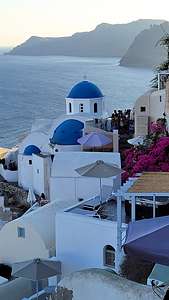 The beautiful white and blue-domed churches of OiaHowever, it was already 4:00 when we arrive on the island, so before checking into our hotel, our bus took us directly to the beautiful town of Oia, famous for its whitewashed houses and blue-domed churches carved into the rugged clifftops.
The beautiful white and blue-domed churches of OiaHowever, it was already 4:00 when we arrive on the island, so before checking into our hotel, our bus took us directly to the beautiful town of Oia, famous for its whitewashed houses and blue-domed churches carved into the rugged clifftops.
This was by far the most crowded village we had been to yet, and it didn’t help that a dramatic sunset was about to take place. It was shoulder to shoulder walking on the pedestrian way. The most popular spot to watch the sunset is by Oia Castle. The crowds there every evening are supposed to be insane, so we changed directions and started walking away from the sunset. I felt like a salmon swimming upstream, but we did seem to be leaving the crowd behind.
It sort of worked and soon we could actually breathe and take in the beautiful views of the whitewashed cubiform houses carved into the lava rock cliffs, overlooking the caldera below.
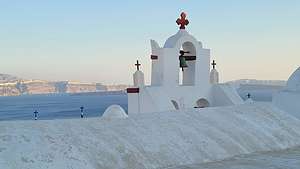 Bells, bells, bellsAnd then I found what I had been looking for - Oia’s famed whitewashed, cubiform churches topped with the famed blue-domes set into the cliffside.
Bells, bells, bellsAnd then I found what I had been looking for - Oia’s famed whitewashed, cubiform churches topped with the famed blue-domes set into the cliffside.
So why were there so many white and blue buildings in Greece? For aesthetics? Because they matched the flag of Greece? Actually, the answer to that is quite different. It is more out of necessity than aesthetics.
First, why the white?
In 1938, the dictator of Greece, Ioannis Metaxas, ordered all citizens to whitewash their homes to try to stop the spread of a cholera outbreak. Now, this might sound silly, but the whitewash contained limestone, which is a powerful disinfectant.
The white of the houses had the additional benefit of making them cooler during the hot Greek summers.
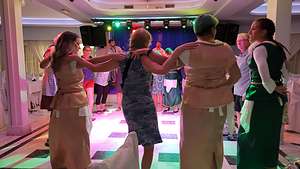 More Greek dancingOk, so what about the blue?
More Greek dancingOk, so what about the blue?
Because it was cheap and easy to make. Fishermen painted their windows and shutters with whatever was left over after painting their boats. The blue used for Greek island homes was made from a mixture of limestone and a cleaning product called “loulaki,” which was a kind of blue talcum powder most islanders had readily available at home. Therefore, blue paint was a practical choice.
When the military dictatorship took over Greece in 1967, they made white and blue mandatory, because they thought it would inspire patriotism.
These laws don’t exist anymore, but now many islanders make the personal choice to paint their homes blue and white, as it has become synonymous with Cycladic architecture.
That evening at dinner, we were treated to an evening of Greek dancers performing for us, and then encouraging us to join in the fun. Although hesitant at first, we all had a great time.
What a full day, and we hadn’t even checked into our hotel yet!
Day 2 - Akrotiri, relaxing by the pool, and wine tasting
.thumbnail.jpg) The donkeys of SantoriniThe next morning, our first in Santorini, we were awoken to the sound of tinkling bells. I ran out onto our balcony and quickly snapped a photo of a man leading a team of donkeys from the stone hut way off in the distance up into town. I found out later that these donkeys had a full-day of work ahead of them carrying tourists up and down the steep zig-zaggy paths from the port to the top of the caldera.
The donkeys of SantoriniThe next morning, our first in Santorini, we were awoken to the sound of tinkling bells. I ran out onto our balcony and quickly snapped a photo of a man leading a team of donkeys from the stone hut way off in the distance up into town. I found out later that these donkeys had a full-day of work ahead of them carrying tourists up and down the steep zig-zaggy paths from the port to the top of the caldera.
Today we had another very full day ahead of us: a field trip to Akrotiri and Wine Tasting. Fortunately, we did manage to squeeze a little down time relaxing at the pool somewhere in between all that. I'm not sure whose day would be more exhausing, ours or those donkeys we saw this morning?
.thumbnail.JPG)
This was the same volcano that blew away half of Santorini, changing it from a round island into a crescent-shaped one, with the harbor now being in the caldera.
.thumbnail.jpg) AkrotiriPrior to the volcanic eruption, the city of Akrotiri was very sophisticated. It had cobblestone streets, an extensive drainage system, and multi-story buildings with luxurious furniture and frescoes covering the walls. It had once been one of the most important Minoan urban centers and ports in the Aegean Sea.
AkrotiriPrior to the volcanic eruption, the city of Akrotiri was very sophisticated. It had cobblestone streets, an extensive drainage system, and multi-story buildings with luxurious furniture and frescoes covering the walls. It had once been one of the most important Minoan urban centers and ports in the Aegean Sea.
Preservation of the settlement is exceptional, making this one of the most significant archaeological sites in Greece.
.thumbnail.jpg) Chill time by the poolThe frescoes that once adorned the walls of the homes of Akrotiri before they were buried in volcanic ash were painstakingly removed and restored. They are now housed in the Prehistoric Museum of Thera, which we would visit tomorrow.
Chill time by the poolThe frescoes that once adorned the walls of the homes of Akrotiri before they were buried in volcanic ash were painstakingly removed and restored. They are now housed in the Prehistoric Museum of Thera, which we would visit tomorrow.
At one time, visitors were allowed to wander down and amongst the ruins, but now because of funding issues in hiring enough security personnel, we were confined to walkways above the ruins. The reason they have insufficient funding is that they lost their major sponsor, Yevgeny Kaspersky, one of the richest oligarchs in Russia, when he was sanctioned by the U.S. back in 2017.
 Koutsoyannopoulos Wine MuseumHowever, we still had a very interesting and educational experience being able to look down on the settlement from the walkways that surrounded the ancient settlement.
Koutsoyannopoulos Wine MuseumHowever, we still had a very interesting and educational experience being able to look down on the settlement from the walkways that surrounded the ancient settlement.
Back at the hotel, we were treated to a few hours of downtime, which we chose to spend at the hotel's lovely pool. We weren't the only ones, as we were soon joined by most of the rest of our tour group.
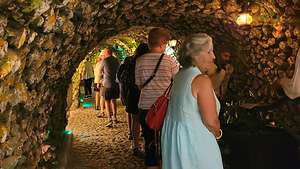 Wine cave in the Koutsoyannopoulos Wine MuseumLater that afternoon, we were back on the bus for one last activity that day - a visit the Koutsoyannopoulos Wine Museum. The winery has been a family business since 1870, when the Koutsogiannopoulos brothers wound up on Santorini island by mistake when they were blown off course by strong winds when trying to get to Syros. Apparently, they liked Santorini, because 150 years later the descendants are still making olive oil and wine here.
Wine cave in the Koutsoyannopoulos Wine MuseumLater that afternoon, we were back on the bus for one last activity that day - a visit the Koutsoyannopoulos Wine Museum. The winery has been a family business since 1870, when the Koutsogiannopoulos brothers wound up on Santorini island by mistake when they were blown off course by strong winds when trying to get to Syros. Apparently, they liked Santorini, because 150 years later the descendants are still making olive oil and wine here.
I have to confess to being a bit of a wine snob now that I live in Sonoma Valley. Their wines are very different from anything I have ever tasted. All I need to make me happy is a dry chardonnay with some texture.
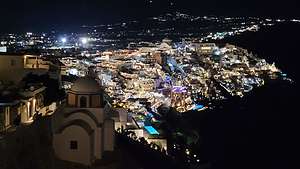 Fira at nightStill it was an awesome museum, nestled in a 300-meter long cave 8 meters below ground, with life size dioramas of the family's history in winemaking. It took them over 20 years to make this museum.
Fira at nightStill it was an awesome museum, nestled in a 300-meter long cave 8 meters below ground, with life size dioramas of the family's history in winemaking. It took them over 20 years to make this museum.
We got to sample four different kinds of wine in a room in the cave, but like I said, they just weren't what I like in a wine. That's not to say they weren't good. There were plenty of people in the winery bar that seemed to be enjoying them just fine.
Later on that evening, Herb and I decided to take a walk from our hotel to the pedestrian alleyways along the top of the cliffs above the caldera. It was nice and quiet, which was a pleasant surprise compared to the mobs we had experienced during the day. Looking out over the edge to the buildings built into the side of the cliffs with their lights ablaze was magical.
Day 3 - Prehistoric Museum of Thera and Paralia Perivolos (Black Sands Beach)
.thumbnail.jpg) The FishermanOur ferry to Crete didn't leave until 6:00 pm tonight, so we pretty much had another full day to enjoy Santorini.
The FishermanOur ferry to Crete didn't leave until 6:00 pm tonight, so we pretty much had another full day to enjoy Santorini.
First up was the Prehistoric Museum of Thera, a perfect follow-up to a visit to the ruins of Akrotiri yesterday. As I mentioned in my write-up about our visit the the Akrotiri Archeological site yesterday, the frescoes that once adorned the walls of the homes there before they were buried in volcanic ash were painstakingly removed and restored. The Prehistoric Museum of Therea is where they now reside for all to enjoy.
 The FlotillaOne of my favorites is called "The Fisherman." I asked Herb to stand next to it so I could take his picture, because he too is a fisherman, but a security guard stopped us and said "no posing."
The FlotillaOne of my favorites is called "The Fisherman." I asked Herb to stand next to it so I could take his picture, because he too is a fisherman, but a security guard stopped us and said "no posing."
I later learned that Greeks think of their artifacts as sacred treasures and consider it disrespectful to pose with them. I think that is why when we were at the Acropolis, security guards started blowing their whistles and yelling to a girl who had a Greek flag wrapped around herself in front of the Parthenon to stop posing.
.thumbnail.jpg) Herb enjoying himself at Paralia Perivolos (Black Sands Beach)Another familiar frescro we saw in the museum was "The Flotilla," which depicted lots of boat activity in a harbor. The harbor must have been a different one than the one we pulled into the other day, because the volcanic eruption had not yet taken place, so there was no caldera yet. The Flotilla fresco showed that the residents of Akrotiri were very involved in commerce and trade with the rest of the Aegean world.
Herb enjoying himself at Paralia Perivolos (Black Sands Beach)Another familiar frescro we saw in the museum was "The Flotilla," which depicted lots of boat activity in a harbor. The harbor must have been a different one than the one we pulled into the other day, because the volcanic eruption had not yet taken place, so there was no caldera yet. The Flotilla fresco showed that the residents of Akrotiri were very involved in commerce and trade with the rest of the Aegean world.
.thumbnail.jpg) Lolo enjoying herself at Paralia Perivolos (Black Sands Beach)Tassos had a real treat for us today! - hint, he had told us to bring our bathing suits! Our bus brought us to the seaside village of Perivolos, in the southeastern corner of Santorini. We were then let loose with the instructions to return to the bus in 4 hours.
Lolo enjoying herself at Paralia Perivolos (Black Sands Beach)Tassos had a real treat for us today! - hint, he had told us to bring our bathing suits! Our bus brought us to the seaside village of Perivolos, in the southeastern corner of Santorini. We were then let loose with the instructions to return to the bus in 4 hours.
While some in our group chose to pass the time wandering through the town, six of us chose to spend it on Paralia Perivolos (Black Sands Beach) - great another chance to swim in the Aegean Sea and practice our synchronized swimming.
For 10 euro, we got two lounge chairs and a beach umbrella for the afternoon. Herb was quite happy with his situation, especially when he was delivered his very large Mythos beer.
I chose to spend my time swimming in the sea.
Then it was back on the bus to get to our 6:00 pm ferry to our final island - Crete.
- ‹ previous
- 4 of 6
- next ›
Santorini location map in "high definition"
Javascript is required to view this map.
